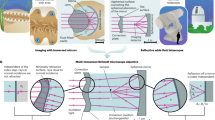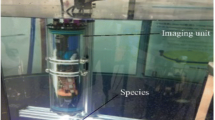Abstract
A condenser has been designed to fulfil the need for high quality dark-field illumination of transparent zooplankton animals. The condenser, which covers fields of up to 30 mm, is designed for use on a stereomicroscope. The condenser uses only reflectors so that it can be constructed without the use of optical glass. A system for permanently fixing the microscope, condenser, light source, cooling system and optional rotating tray is presented. Coupled with an electronic flash, the condenser is an important tool in investigating structural and functional features of living animals. Examples of its use in describing some aspects of the biology of living specimens of the salp Thalia democratica are given.
Similar content being viewed by others
Literature cited
Carlisle, D. B.: Alcune osservazioni sulla meccanica dell' alimentazione della Salpa. Pubbl. Staz. zool. Napoli 22, 146–154 (1950)
Fedele, M.: Sulla nutrizione degli animali pelagici. III. Ricerche dei Salpidae. Boll. Soc. Nat. Napoli 45, 49–118 (1933).
Foxton, P.: The distribution and life history of Salpa thompsoni Foxton with observations on a related species, Salpa gerlachei Foxton. “Discovery” Rep. 34, 1–116 (1966).
Author information
Authors and Affiliations
Additional information
Communicated by G.F. Humphrey, Cronulla
Rights and permissions
About this article
Cite this article
Heron, A.C. A dark-field condenser for viewing transparent plankton animals under a low-power stereomicroscope. Marine Biol. 2, 321–324 (1969). https://doi.org/10.1007/BF00355711
Accepted:
Issue Date:
DOI: https://doi.org/10.1007/BF00355711




